Observability with Grafana: A Complete DevOps Guide
Discover how DevOps engineers and SREs can achieve comprehensive observability using Grafana. Learn about metrics, logs, traces, dashboards, and automation with practical examples and code for real-world monitoring.
Introduction
Modern DevOps and SRE teams face increasing complexity in distributed systems, requiring a robust observability strategy. Grafana has become a leading open-source observability platform, enabling teams to visualize, analyze, and act on their telemetry data. In this guide, we’ll explore how to implement observability with Grafana, using practical examples and code to monitor metrics, logs, and traces for actionable insights.
What Is Observability?
Observability is the ability to understand a system's internal state by collecting and analyzing telemetry data—primarily metrics, logs, and traces. True observability enables teams to detect issues, diagnose root causes, and optimize performance proactively. Grafana’s ecosystem supports all pillars of observability, making it ideal for modern cloud-native environments.
Key Components of Observability with Grafana
- Metrics: Quantitative data describing system health (e.g., CPU usage, request rate). Collected by Prometheus and visualized in Grafana.
- Logs: Unstructured text records of events. Centralized using Loki and explored in Grafana.
- Traces: End-to-end request flows across distributed systems. Collected via Tempo or OpenTelemetry and visualized in Grafana.
- Dashboards: Interactive panels aggregating telemetry data for real-time monitoring and alerting.
Setting Up Observability with Grafana
1. Instrument Your Application
Instrumentation is the process of adding code or agents to your application to emit telemetry data. Grafana supports native and OpenTelemetry-based instrumentation:
- OpenTelemetry: Standardized SDKs (Java, .NET, Go, etc.).
- Grafana Beyla: eBPF-based, code-free instrumentation for network and process telemetry.
# Example: Instrumenting a Node.js app with OpenTelemetry SDK
npm install @opentelemetry/api @opentelemetry/sdk-node
2. Deploy the Grafana Observability Stack
The full stack typically includes:
- Prometheus for metrics collection
- Loki for log aggregation
- Tempo for distributed tracing
- Grafana for visualization and alerting
# Example: docker-compose.yaml for local observability stack
version: '3.7'
services:
grafana:
image: grafana/grafana:latest
ports:
- "3000:3000"
prometheus:
image: prom/prometheus:latest
ports:
- "9090:9090"
loki:
image: grafana/loki:latest
ports:
- "3100:3100"
tempo:
image: grafana/tempo:latest
ports:
- "3200:3200"
3. Configure Data Sources in Grafana
After deploying the stack, add data sources in Grafana:
- Navigate to Configuration > Data Sources.
- Add Prometheus, Loki, and Tempo endpoints.
4. Build Observability Dashboards
Grafana dashboards provide a unified view across all telemetry types. You can create dashboards via the UI or as code (JSON/Provisioning):
{
"dashboard": {
"title": "Application Health",
"panels": [
{"type": "graph", "title": "CPU Usage", "targets": [{"expr": "process_cpu_seconds_total"}]}
]
}
}
Store dashboard JSON as ConfigMap in Kubernetes for automated provisioning.
5. Automate Observability as Code
Leverage Observability as Code to version-control dashboards and alerting rules. Integrate with CI/CD for reproducible observability environments:
# Example: Provision dashboard using Grafana CLI
grafana-cli dashboards import <dashboard-id>
With the Grafana Foundation SDK or tools like grafanactl, you can define and manage observability resources as code, ensuring consistency and traceability across environments.
Practical Example: Visualizing Application Traces
Let's trace a sample application's requests using OpenTelemetry and display them in Grafana:
- Instrument your application with the OpenTelemetry SDK.
- Send spans to Tempo or Grafana Cloud OTLP endpoint.
- In Grafana, use the Traces data source to explore distributed traces visually.
// Node.js OpenTelemetry example
const { NodeTracerProvider } = require('@opentelemetry/sdk-trace-node');
const provider = new NodeTracerProvider();
provider.register();
// ... instrument HTTP server
Enhancing Observability with Alerts and Service Maps
Grafana supports alerts on metrics, logs, and traces. Set up Alertmanager for notifications. Use Service Inventory and Service Map dashboards to visualize health and dependencies across microservices, accelerating incident response.
Conclusion
Observability with Grafana empowers DevOps and SRE teams to gain deep visibility into their systems. By combining metrics, logs, and traces in unified dashboards, you can detect anomalies, troubleshoot faster, and maintain high availability. Automate your observability workflows as code to scale and standardize monitoring across environments.




